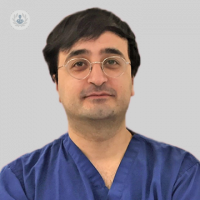Considering a tummy tuck? Expert insight on what results to expect
Written in association with:In this detailed guide to life after tummy tuck surgery, highly respected plastic surgeon Mr Brian Simons shares his expert insight on what types of results patients can expect from the procedure, including scarring, and the factors which can affect this. The renowned specialist also explains how various types of tummy tuck surgery differ and sheds light on the recovery process following the procedure.

Is a tummy tuck major surgery?
There are a number of types of tummy tuck procedure, including:
- full tummy tuck
- fleur-de-lis tummy tuck
- mini tummy tuck
While all types of tummy tuck operations are invasive procedures, they vary in the amount of tissue that is taken away. As a general rule, the more tissue that is removed, the more recovery time is needed but after around four to six weeks, patients of all types of tummy tuck should be back to a normal activity level.
How long do the results last? Can results be affected by weight gain or loss?
The results of a tummy tuck can last a lifetime but this depends on the patient profile. For example, we see many patients who have recently undergone weight loss surgery, such as a gastric band or sleeve. Unfortunately we often see that after a tummy tuck procedure to remove excess tissue, these patients may go on to gain or lose weight again in a certain way which obviously affects their results. It is not ideal to undergo big weight changes after a tummy tuck procedure because the tissue will react differently after surgery, so the cosmetic results can vary a lot.
Therefore, when you have decided to go down the route of having a tummy tuck, it is important that you maintain your weight for as long as possible. Ideally, patients who have lost weight, for instance, through a bariatric procedure, should maintain their weight for about three to six months before having a tummy tuck operation.
How much scarring is visible after a tummy tuck?
The scarring depends greatly on the type of tummy tuck procedure that you undergo. With a mini tummy tuck, the scarring is very low in the pubic area and can appear as similar to the scarring from a C-section.
Scarring from a full tummy tuck, on the other hand, can go from hip to hip but this depends on how much tissue is removed. Nowadays, to minimise the visibility of scarring from any tummy tuck procedure, we tend to ensure the scar is as low as possible so it is always hidden below the top of underwear or bikinis.
Is a tummy tuck suitable for everyone?
Tummy tuck procedures are not always suitable for everybody. Firstly, a patient has to have a good condition of health to be able to undergo surgery.
It’s also important to have realistic expectations as some patients are under the misconception that a tummy tuck procedure will leave them with a very flat abdomen. Many people are unaware of the limitations of tummy tuck procedures and do not understand that we do not take fat from inside the belly in this type of surgery. It is not possible to do so and the fat around the organs and inside the belly can sometimes create a bulge which gives the abdomen a bloated or pregnant appearance. Therefore, the deeper tissues should be taken into consideration when establishing your expectations for the results of your tummy tuck procedure.
When is the best time to get a tummy tuck?
There is no ideal time to undergo a tummy tuck procedure. I would recommend avoiding seasons of the year when the weather is particularly hot or cold so that the temperature is as constant as possible. This is because after surgery you will have dressings and special garments on the area and moderate temperatures make wearing them significantly more comfortable. Additionally, sweating can make it difficult to keep the wounds clean, meaning they may not heal well and as a result, the scars will not look very nice.
If you are considering a tummy tuck procedure and would like to discuss your options with Mr Simons, you can do so by visiting his Top Doctors profile.


